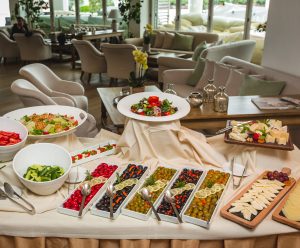In the corporate world, every detail matters. From the décor of a meeting space to the way emails are signed, businesses know that impressions can make or break deals. When it comes to events—whether it’s a board meeting, product launch, training seminar, or gala dinner—catering becomes a powerful tool to communicate professionalism, hospitality, and brand identity.
Corporate catering is not just about satisfying hunger. It’s about creating an atmosphere where clients feel valued, employees feel motivated, and every guest leaves with a lasting impression. The food, presentation, service, and execution all speak volumes about the company hosting the event.
This article explores the keys to impressing clients through corporate catering, showing how thoughtful choices can transform events into unforgettable experiences.
1. Why Corporate Catering Matters
Unlike private parties or weddings, corporate events are high-stakes environments. The right catering can:
- Reflect the company’s brand and professionalism.
- Create an inviting environment that fosters networking and collaboration.
- Demonstrate attention to detail that impresses clients and stakeholders.
- Strengthen relationships by making guests feel valued.
Food becomes part of the corporate message—and catering is the medium through which it’s delivered.
2. Understanding the Purpose of the Event
Before planning the menu or presentation, a caterer must understand the type and purpose of the event.
- Boardroom meetings: Require efficiency, discretion, and refined simplicity. Finger foods, boxed meals, and seamless service work best.
- Product launches: Demand creativity and innovation in menu design and presentation to align with the excitement of the launch.
- Conferences and seminars: Need diverse menus with dietary inclusivity and quick service to accommodate large groups.
- Corporate galas and banquets: Call for sophistication, multi-course meals, and show-stopping presentations.
Matching the catering style to the event’s purpose ensures harmony and enhances the overall experience.
3. Menu Design: Balancing Flavor and Function
The menu is the foundation of corporate catering, but unlike casual events, functionality plays a huge role.
Key Principles:
- Simplicity meets elegance: Choose dishes that are delicious yet easy to eat without mess.
- Dietary inclusivity: Include vegetarian, vegan, gluten-free, halal, or allergy-conscious options to ensure every guest feels accommodated.
- Energy-focused choices: For all-day meetings, light meals and snacks prevent sluggishness and maintain productivity.
- Cultural sensitivity: Incorporate regional flavors or themes when catering for international clients.
For instance, a corporate breakfast may feature yogurt parfaits, artisanal pastries, and fresh fruit, while a gala might highlight multi-course fine dining.
4. Presentation: Reflecting Professionalism
Corporate catering presentation should mirror the company’s image.
- Buffet setups: Organized, elegant, and efficient.
- Plated meals: Ideal for formal dinners, with symmetry and refinement.
- Brand integration: Incorporating company logos into menus, desserts, or even ice sculptures adds a branded touch.
- Minimalist elegance: Simple, clean lines in presentation evoke sophistication without distraction.
The visual appeal of food becomes part of the branding exercise for the company.
5. Service Excellence: The Human Touch
In catering, service is just as important as food. For corporate events, service staff represent both the caterer and, by extension, the host company.
- Professionalism: Staff should be well-trained, discreet, and responsive.
- Timing: Courses or buffets should be ready exactly when needed, as corporate schedules are precise.
- Courtesy: Warm, polite interactions enhance the guest experience and reflect positively on the client.
Impeccable service demonstrates that the company values its guests and pays attention to every detail.
6. Creating the Right Atmosphere
Corporate catering extends beyond food and service to atmosphere creation.
- Ambiance alignment: The catering setup should reflect the formality and tone of the event.
- Décor integration: Table settings, floral arrangements, and serving ware should complement the event’s theme.
- Interactive stations: For networking events, live food stations encourage conversation and engagement.
The atmosphere created by catering helps clients associate the company with hospitality and professionalism.
7. Technology in Corporate Catering
Modern corporate events increasingly integrate technology, and catering has kept pace.
- Digital menus: QR codes reduce paper waste and offer interactive menu exploration.
- Hybrid event catering: Providing meal boxes delivered to remote attendees of virtual conferences.
- Smart scheduling: Apps for meal pre-ordering or dietary customization streamline service.
Tech-driven catering demonstrates innovation, aligning with the forward-thinking values of modern corporations.
8. Sustainability as a Corporate Value
Many businesses now emphasize Corporate Social Responsibility (CSR), and catering offers a chance to reflect this.
- Eco-friendly practices: Biodegradable packaging, reusable serving ware, and local sourcing.
- Zero waste initiatives: Donating leftovers or composting.
- Carbon-conscious menus: Offering plant-based or low-impact dishes.
Sustainable catering not only impresses clients but also aligns with corporate values, enhancing reputation.
9. Case Studies: Successful Corporate Catering
Example 1: Tech Company Product Launch
A global tech brand wowed clients by integrating futuristic food displays with LED-lit buffet stations and a plant-based menu to highlight innovation and sustainability.
Example 2: Financial Firm Gala Dinner
A financial services company hosted a black-tie gala where catering featured a five-course meal paired with fine wines, seamlessly blending luxury with efficiency.
Example 3: Start-Up Networking Event
A young start-up used interactive food stations—taco bars and DIY dessert stations—to create an informal, engaging environment for networking.
These examples show how tailored catering strategies enhance brand identity while leaving memorable impressions.
10. Keys to Client Impressions Through Catering
To summarize, here are the essential strategies for impressing clients through catering:
- Understand the event purpose and tailor accordingly.
- Design inclusive, practical, and elegant menus.
- Prioritize presentation as a reflection of professionalism.
- Ensure flawless, courteous service.
- Create atmosphere aligned with the brand and theme.
- Leverage technology for efficiency and innovation.
- Integrate sustainability to showcase responsibility.
- Focus on storytelling—make food part of the company’s narrative.
When all these elements align, catering transforms from service into strategy.
Conclusion: Food as a Business Statement
In the corporate world, every detail is an opportunity to build or strengthen relationships. Catering, often underestimated, is one of the most powerful ways to impress clients. It communicates hospitality, professionalism, and respect—values that define how a company is perceived.






